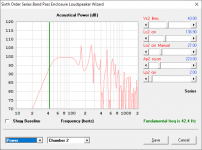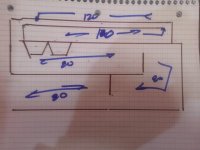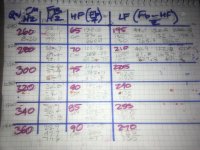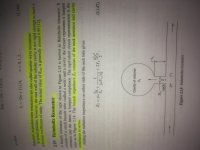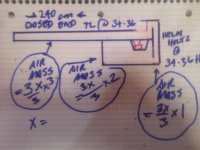View attachment 905853
Josh Ricci´s test recommend using the CEA-2010 short burst test.
This is the exact problem. The CEA-2010 short burst test allows for the Helmholtz resonance to gradually increase and build up before applying full power. A true transient will push the driver in a BR out of its linear travel and it will not have a chance to normalize around the zero crossing again until the main part of the energy from a drum strike has passed. This is quite evident just by watching a 218 BR box at high power at a live venue.
It is also quite evident why a horn, TH or high order QW BP will sound soo much better at transient content like drums, and the CEA-2010 short burst test will "hide" this problem with BR boxes.
This smells like real and sounds like fact. I think you have the thing sorted better than people might assume it functions
I'm sure Brian probably used similar to find ‘dog food duct’ and its area of concern/resolve. (Great read btw).
You sparked my "creative juices" this morning. A TH is basically a BP6S taken to its logical extremes, and a TH designed for bass duty can be sim'd as a series of stepped straight segments rather than one or two expanding segments.
Unfortunately, Hornresp's TH model does not allow one to insert a restriction in the TH's path.
But what if I sim'd it as a BP6S instead? The "restriction" in this case would be the vent for Volume 2.
So, that's exactly what I did, and the results look promising. Quite promising. I have a couple of ideas of how this can be transferred to a BOXPLAN workbook, which will allow for optimization. I'll probably work on that later today, after I've finished some "housework".
Note: the resulting FR backs up something else I've said - a TH is basically a BP6S with the out-of-band noise being used to extend its passband 🙂
Attachments
Last edited:
😱Oh nice!!
Less impactful until the entire path has been created , I scrub/strip down the ‘roar’ or ‘paraflex ‘ into a TH1 (Ap1) to try and make L45 a mass load window at exit after a bulk of L23 creates an otherwise HF abundance in SPL.
Using your idea here, and what i mentioned sounds exciting to pick and choose areas to ‘tease/annoy’ the first throat entry tapped driver or ‘both’ taped driver locations to observe the system to see it as ‘a long qw system with an ‘airpump placed at the start of two pipes in series, OR as the SAME long qw pipe with some mechanical assistance dropped in the middle to reenergize the lag of momentum of a lot of air needing some more muscle spread out in moving it best?
8th order BP kind of swapped as similar is ‘okay’but hard on my brain in angles and dangles of a 90 @ driver, etc. that we already kindof fudge periodically..
But forcing a system to tell us if tapping is helpful vs the wider harmonic of ODTL vs both ....is always a question or idea to ponder hmm
Less impactful until the entire path has been created , I scrub/strip down the ‘roar’ or ‘paraflex ‘ into a TH1 (Ap1) to try and make L45 a mass load window at exit after a bulk of L23 creates an otherwise HF abundance in SPL.
Using your idea here, and what i mentioned sounds exciting to pick and choose areas to ‘tease/annoy’ the first throat entry tapped driver or ‘both’ taped driver locations to observe the system to see it as ‘a long qw system with an ‘airpump placed at the start of two pipes in series, OR as the SAME long qw pipe with some mechanical assistance dropped in the middle to reenergize the lag of momentum of a lot of air needing some more muscle spread out in moving it best?
8th order BP kind of swapped as similar is ‘okay’but hard on my brain in angles and dangles of a 90 @ driver, etc. that we already kindof fudge periodically..
But forcing a system to tell us if tapping is helpful vs the wider harmonic of ODTL vs both ....is always a question or idea to ponder hmm
Last edited:
My only idea i really think is of real benefit to us all is not about BR.
Its about harmonic intervals of phase change filtering aling the expanding geometry of an acoustical gain based on qw length of a destination in Hz, but also response shape that dictated by the amount of ‘hits’ at 80 or 120 or either in a marhematical version of 320, 240/80cm or 320, 80/80/80/80.... this (in groups of 3 remove the void at Fb/3in Pipes folded.
Its about harmonic intervals of phase change filtering aling the expanding geometry of an acoustical gain based on qw length of a destination in Hz, but also response shape that dictated by the amount of ‘hits’ at 80 or 120 or either in a marhematical version of 320, 240/80cm or 320, 80/80/80/80.... this (in groups of 3 remove the void at Fb/3in Pipes folded.
Attachments
Chart it and dig into halfwave as open ended pipes too. If theres something here, i hope its useful for EVERyZoNE!!? (Im Looking for the swedish DIY forum with stufmdy on folding i hsd book marked)
A bunch of dog food ducts are rather harmonious if youre a puppy? maybe folding is jyst a impedance drop to LP filter. And expanding aling the route is delicate but learning it isnt too far ferched?
Resonances of open air columns
A bunch of dog food ducts are rather harmonious if youre a puppy? maybe folding is jyst a impedance drop to LP filter. And expanding aling the route is delicate but learning it isnt too far ferched?
Resonances of open air columns
Attachments
Last edited:
View attachment 905853
Josh Ricci´s test recommend using the CEA-2010 short burst test.
This is the exact problem. The CEA-2010 short burst test allows for the Helmholtz resonance to gradually increase and build up before applying full power. A true transient will push the driver in a BR out of its linear travel and it will not have a chance to normalize around the zero crossing again until the main part of the energy from a drum strike has passed. This is quite evident just by watching a 218 BR box at high power at a live venue.
It is also quite evident why a horn, TH or high order QW BP will sound soo much better at transient content like drums, and the CEA-2010 short burst test will "hide" this problem with BR boxes.
I'm not convinced this is true. I've used many BR boxes, and dropped a lot of power into them, and never once seen them bottom out on the first half-cycle (or whatever), for the port to then restrict cone excursion.
Helmholtz resonance does not take a few cycles to take effect: they are, in fact, minimum-phase systems with the same time domain performance as a sealed box with the same frequency response.
I'd still like to see compression performance of a ROAR design: that narrow section looks suspect to me.
Chris
Last edited:
Chart it and dig into halfwave as open ended pipes too. If theres something here, i hope its useful for EVERyZoNE!!? (Im Looking for the swedish DIY forum with stufmdy on folding i hsd book marked)
Resonances of open air columns
Resonances of open air columns
I'm not convinced this is true. I've used many BR boxes, and dropped a lot of power into them, and never once seen them bottom out on the first half-cycle (or whatever) of a cycle, for the port to then restrict cone excursion.
Helmholtz resonance does not take a few cycles to take effect: they are, in fact, minimum-phase systems with the same time domain performance as a sealed box with the same frequency response.
I'd still like to see compression performance of a ROAR design: that narrow section looks suspect to me.
Chris
Cone failure in a Faital pro 18” driver is documented (in a paraflex) . Its a ‘lesser’ model, and the cone is not ribbed, rigid or thickened/pressed/shaped/etc in any way... but theres the concern, You are not wrong sir. Its on a Qw FB group with pics.
I'm not convinced this is true. I've used many BR boxes, and dropped a lot of power into them, and never once seen them bottom out on the first half-cycle (or whatever), for the port to then restrict cone excursion.
Same here. I suspect the observed difference is driver dependent and depends on how the driver's motor handles signals that sends the coil out of the Xmax region.
The compression ratio of the ROAR series first segments varies between 0,66xSd and 0,63xSd if I recall correctly, one could approximate it to 2/3 of Sd for each model.
Regarding BR helmholtz resonance buildup time and it's relation to excursion, perhaps the inherit inertia of the air mass in both enclosure and port limits the excursion, but this is not the same as saying that a helmholtz resonance is established, rather it would mean that the system acts as a leaky closed box, meaning reduced overall output compared to when the resonance later is established, once the system has retained its steady state properties, just a thought.
Regarding BR helmholtz resonance buildup time and it's relation to excursion, perhaps the inherit inertia of the air mass in both enclosure and port limits the excursion, but this is not the same as saying that a helmholtz resonance is established, rather it would mean that the system acts as a leaky closed box, meaning reduced overall output compared to when the resonance later is established, once the system has retained its steady state properties, just a thought.
Fold a qw pipe, tuned to 35.8hz, in half at 120cm(71.6hz). Then make that large chamber 80cm long(107.4hz). Do we get a void at 107 or above?
Do the same but in a compound horn. 120cm fold, then 120cm to exit. and the that 80 cm misses the encounter by 80 cm.... but its 40 cm from the 240??
If we give 20 cm of ‘PARFLEX to a compound horn and click out heals together 3 times i dont think we are in kansas anymore? What is the vector sum of leftovers at the place we hear them?
I think 240, is 3x80 offset(Martin King). But really 120/120 offset and then 80 is the wide and csa flare in those steps is a guaranteed filter/gain To a flat ? martin didnt explore ‘tapped’. He had to leave something to do when he retired? He left off at BIB.. hes almost retired. he likes bass reflex.
He LOVES ROAR, but doesnt realize it. He doesnt do ‘tapped drivers..
I think he does compound closed end TL, with a rear vented Bas reflex at that tune. Phase just traveled twice to 240, the closed end far awsy at 240, and helmholtz to a flip as well at the driver. But a polarity, not a full cycle or 1/4... or.
Please sim the idea. its a super duper TL eating a MLTL for dinner!
I think all of you men are part of something you dont realize? you are significant in everything that has taken place in this stuff since the moment you began. your work ehoes and mirrors everywhere. As did the previous to yours. You are all part of a function and machine with a cycle and all sprockets, cogs, chains, cam gears and bellcranks to its success. dont ever forget it all is broken without you. And is nothing without Your efforts, your ideas, your contributions. your THAM, ROAR , HROAR, MLTL, Dog food Duct loaded Qw PIPE, and paraflex, bass reflex... the consumer doesnt appreciate that. but people like myself absolutely do. life is a lot of things, but in many wAys a pipe dream, its been excited. You people did that! Look!! Its everywhere,
Do the same but in a compound horn. 120cm fold, then 120cm to exit. and the that 80 cm misses the encounter by 80 cm.... but its 40 cm from the 240??
If we give 20 cm of ‘PARFLEX to a compound horn and click out heals together 3 times i dont think we are in kansas anymore? What is the vector sum of leftovers at the place we hear them?
I think 240, is 3x80 offset(Martin King). But really 120/120 offset and then 80 is the wide and csa flare in those steps is a guaranteed filter/gain To a flat ? martin didnt explore ‘tapped’. He had to leave something to do when he retired? He left off at BIB.. hes almost retired. he likes bass reflex.
He LOVES ROAR, but doesnt realize it. He doesnt do ‘tapped drivers..
I think he does compound closed end TL, with a rear vented Bas reflex at that tune. Phase just traveled twice to 240, the closed end far awsy at 240, and helmholtz to a flip as well at the driver. But a polarity, not a full cycle or 1/4... or.
Please sim the idea. its a super duper TL eating a MLTL for dinner!
I think all of you men are part of something you dont realize? you are significant in everything that has taken place in this stuff since the moment you began. your work ehoes and mirrors everywhere. As did the previous to yours. You are all part of a function and machine with a cycle and all sprockets, cogs, chains, cam gears and bellcranks to its success. dont ever forget it all is broken without you. And is nothing without Your efforts, your ideas, your contributions. your THAM, ROAR , HROAR, MLTL, Dog food Duct loaded Qw PIPE, and paraflex, bass reflex... the consumer doesnt appreciate that. but people like myself absolutely do. life is a lot of things, but in many wAys a pipe dream, its been excited. You people did that! Look!! Its everywhere,
Last edited:
The compression ratio of the ROAR series first segments varies between 0,66xSd and 0,63xSd if I recall correctly, one could approximate it to 2/3 of Sd for each model.
Regarding BR helmholtz resonance buildup time and it's relation to excursion, perhaps the inherit inertia of the air mass in both enclosure and port limits the excursion, but this is not the same as saying that a helmholtz resonance is established, rather it would mean that the system acts as a leaky closed box, meaning reduced overall output compared to when the resonance later is established, once the system has retained its steady state properties, just a thought.
Yes, you are a cavity, but wheres the ‘neck’. Or:
It can be seen in sim. but its not obvious or able to be in Hr, so you forced it at the HROAR mod and mass loaded ROAR was born?
Attachments
Same here. I suspect the observed difference is driver dependent and depends on how the driver's motor handles signals that sends the coil out of the Xmax region.
Or:
(Thought)
If a gas vapor was a liquid it would cavitate as turbulence is to a propellor/screw. The high pressure area of a closed end pipe is a submarine in the north atlantic at 800 feet when the commander orders a flank bell rudder amid ship, blow all main ballast tanks , bow planes to surface ship,. and turbulence still, isnt cavitation. high pressure is to boiling what chuffing is to pipes. Phase change.
Last edited:
The compression ratio of the ROAR series first segments varies between 0,66xSd and 0,63xSd if I recall correctly, one could approximate it to 2/3 of Sd for each model.
Regarding BR helmholtz resonance buildup time and it's relation to excursion, perhaps the inherit inertia of the air mass in both enclosure and port limits the excursion, but this is not the same as saying that a helmholtz resonance is established, rather it would mean that the system acts as a leaky closed box, meaning reduced overall output compared to when the resonance later is established, once the system has retained its steady state properties, just a thought.
Martinsson, if you play around in Hornresp, it's easy to see that BRs are minimum-phase. That means a sealed box EQ'd to the same frequency response will have exactly the same time domain performance. ie, there's no "build-up time" in a Helmholtz Resonator.
I suspect this is a similar argument to when people argue against feedback in amplifiers: they think that the circuit produces an error, which is then corrected by the feedback network.
In fact, the feedback network corrects errors instantaneously, as if the parts are mechanically coupled by levers etc: when picturing a see-saw (at a playground or park), one side does not move down without the other side moving up. They are joined and act as one.
In the same way, the Helmholtz Resonance occurs as soon as the correct frequency is present inside the cabinet. Like the see-saw, without delay.
Chris
Last edited:
But we can make a parafkex helmholtz in HR. Just remove all ‘offsets’.
VrcLrc and Ap1/Lp just need a hint of disproportion in Nd and its flagging a helmholtz freq. in OD too (i thuink?)
And we can sim a roar in a way to create that too(if not close)
VrcLrc and Ap1/Lp just need a hint of disproportion in Nd and its flagging a helmholtz freq. in OD too (i thuink?)
And we can sim a roar in a way to create that too(if not close)
Last edited:
Why Frequency? Why Not the pressure? The frequency is ahead of the action as result. Not without pressure is a resulting toot toot noise? The sustem pressure in transient is ?? I dunno, but this sure is trickyMartinsson, if you play around in Hornresp, it's easy to see that BRs are minimum-phase. That means a sealed box EQ'd to the same frequency response will have exactly the same time domain performance. ie, there's no "build-up time" in a Helmholtz Resonator.
I suspect this is a similar argument to when people argue against feedback in amplifiers: they think that the circuit produces an error, which is then corrected by the feedback network.
In fact, the feedback network corrects errors instantaneously, as if the parts are mechanically coupled by levers etc: when picturing a see-saw (at a playground or park), one side does not move down without the other side moving up. They are joined and act as one.
In the same way, the Helmholtz Resonance occurs as soon as the correct frequency is present inside the cabinet. Like the see-saw, without delay.
Chris
Last edited:
If i do this(pic) using Brians TL math to find a driver that likes 240 cm and 200 cm2🙂 its kinda interesting, mltl /TL but is that ‘close’ to helmholtz or not? it needs to be ratios out (hence the x = ?, but it works as 200 cm2 at 240(tl) and 2/2 to 1/3(?) of that as a chamber with a 200 cm2 tube on it mltl style, yet bass reflex or helmholtz or mltl? Its anything if i skoot it around?
Attachments
Last edited:
View attachment 905853
Josh Ricci´s test recommend using the CEA-2010 short burst test.
This is the exact problem. The CEA-2010 short burst test allows for the Helmholtz resonance to gradually increase and build up before applying full power. A true transient will push the driver in a BR out of its linear travel and it will not have a chance to normalize around the zero crossing again until the main part of the energy from a drum strike has passed. This is quite evident just by watching a 218 BR box at high power at a live venue.
It is also quite evident why a horn, TH or high order QW BP will sound soo much better at transient content like drums, and the CEA-2010 short burst test will "hide" this problem with BR boxes.
What exactly would you call a true transient?
I don't see a real problem in hiding...makes no sense so far.
A sub contributes it's share of transient response, the portion within its freq domain. If it contributes beyond that range, through distortion, over excursion, etc, then not good.
Have you ever pulsed a sub alone with just a dirac pulse? And tried to audibly compare one sub vs another? It's damn hard to evaluate a sub's transient response when it's the only driver playing.
There is nothing i can see to give one type box al great advantage over the others, if they are truly well designed.
The only types i would say have an advantage are both sealed, .....sealed itself and FLH.
In fact, the feedback network corrects errors instantaneously, as if the parts are mechanically coupled by levers etc:
In the same way, the Helmholtz Resonance occurs as soon as the correct frequency is present inside the cabinet. Like the see-saw, without delay.
The airmass inside a bass reflex box is not the same as a lever. It is a spring, not mechanically coupled. It is quite hard to get a directly coupled lever to resonate without adding some kind of elasticity into the system.
Look at the group delay graph of a BR. There is definitely some delay around the port tuning.
If feedback networks did corrects the errors instantaneously then why do you need to limit the bandwidth of a high gain amp with negative feedback to avoid oscillation?
- Home
- Loudspeakers
- Subwoofers
- Design principle diversity below 100Hz in professional applications

